
You don’t have to be a marketing pro to create great emails. With the right idea, timing, and template, anyone can send messages that people actually want to open.
In this article, we’ll walk you through 20 marketing email examples and templates you can easily personalize and send with Textmagic to boost engagement and conversions.
Use Textmagic email marketing templates
Getting started with email marketing templates is easier than you think. Navigate to Textmagic’s Compose an email page and click Add content in the Content section. Click Try our new Drag’n’drop editor > Pre-built templates.
Choose the template you want and edit as you wish, then name and save it. Go back to the Compose an email page and insert the template.
We’ve prepared a quick video tutorial below to show you how it’s done.
You can use the Textmagic email campaign feature to:
- Save time. Skip the blank page and start with a visually appealing layout.
- Customize on the go. Edit text, swap images, and match your brand colors.
- Add a personal touch. Use dynamic fields to include names or other details automatically.
- Schedule and send. Plan your campaigns ahead of time or send instantly.
- Measure success. Track opens, clicks, and responses to see what resonates most.
In the following sections, we’ll go over 20 examples from Textmagic’s library of 1,600+ professionally designed email templates, ready for you to personalize and send, no design experience required.
Welcome emails
The welcome email is one of the most popular email marketing examples. It’s the first touchpoint between a brand and its new subscribers, as they set the tone for future interactions. They can help you:
- Make a strong first impression
- Demonstrate your brand’s personality
- Establish trust with your users
Typical messages in this category contain a warm greeting and an introduction to the brand’s values and offerings. They may also include a special welcome offer or call-to-action.
1. Personal welcome email
A personal welcome email addresses the subscriber by name, creating a closer connection. It often includes tailored content based on the subscriber’s preferences or behavior, which can lead to increased engagement and higher open rates.
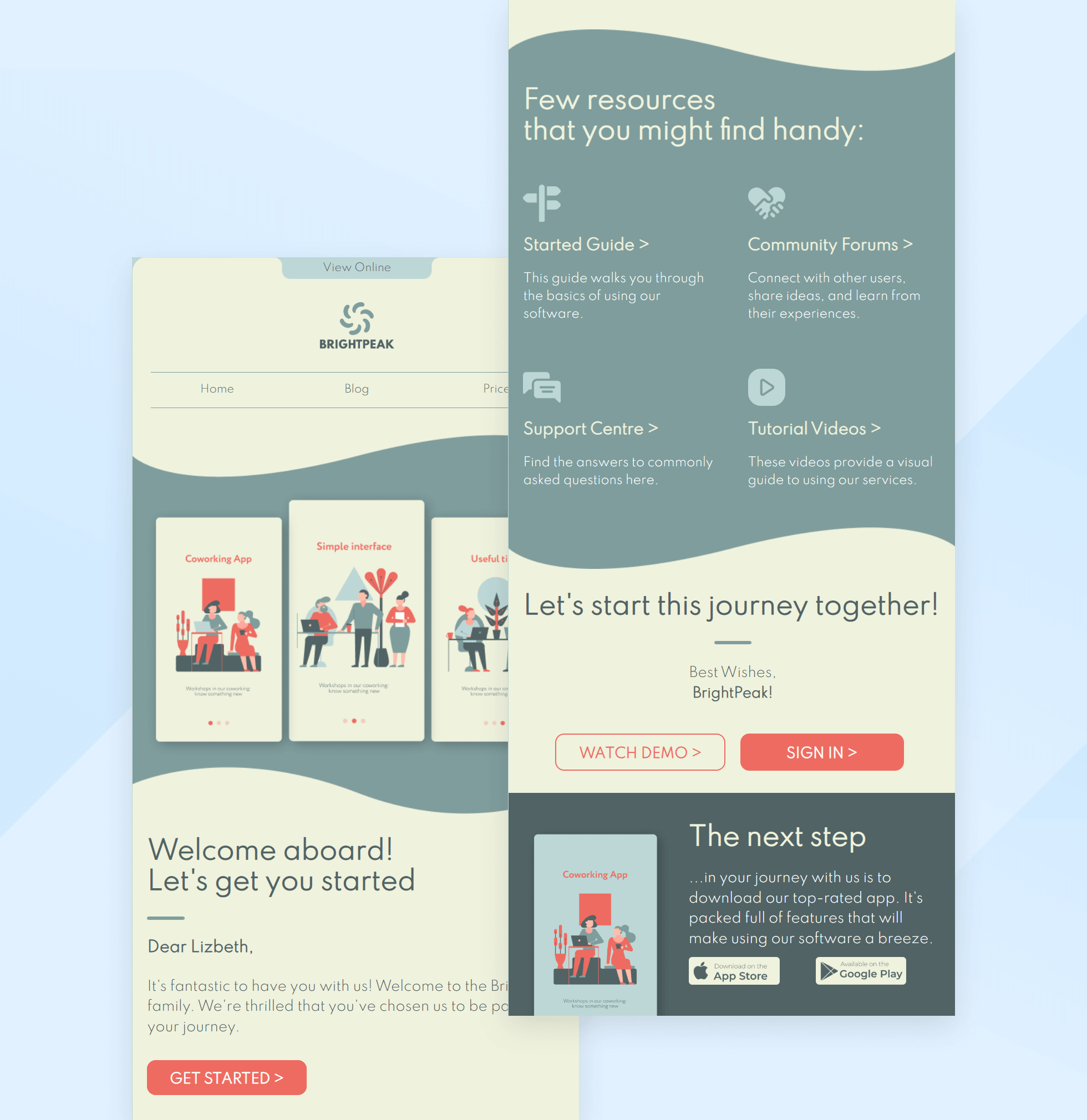
2. Brand introduction email
A brand introduction email provides new subscribers with an overview of the brand’s mission, values, and key products or services. This establishes a strong brand identity and educates subscribers about what sets the brand apart.
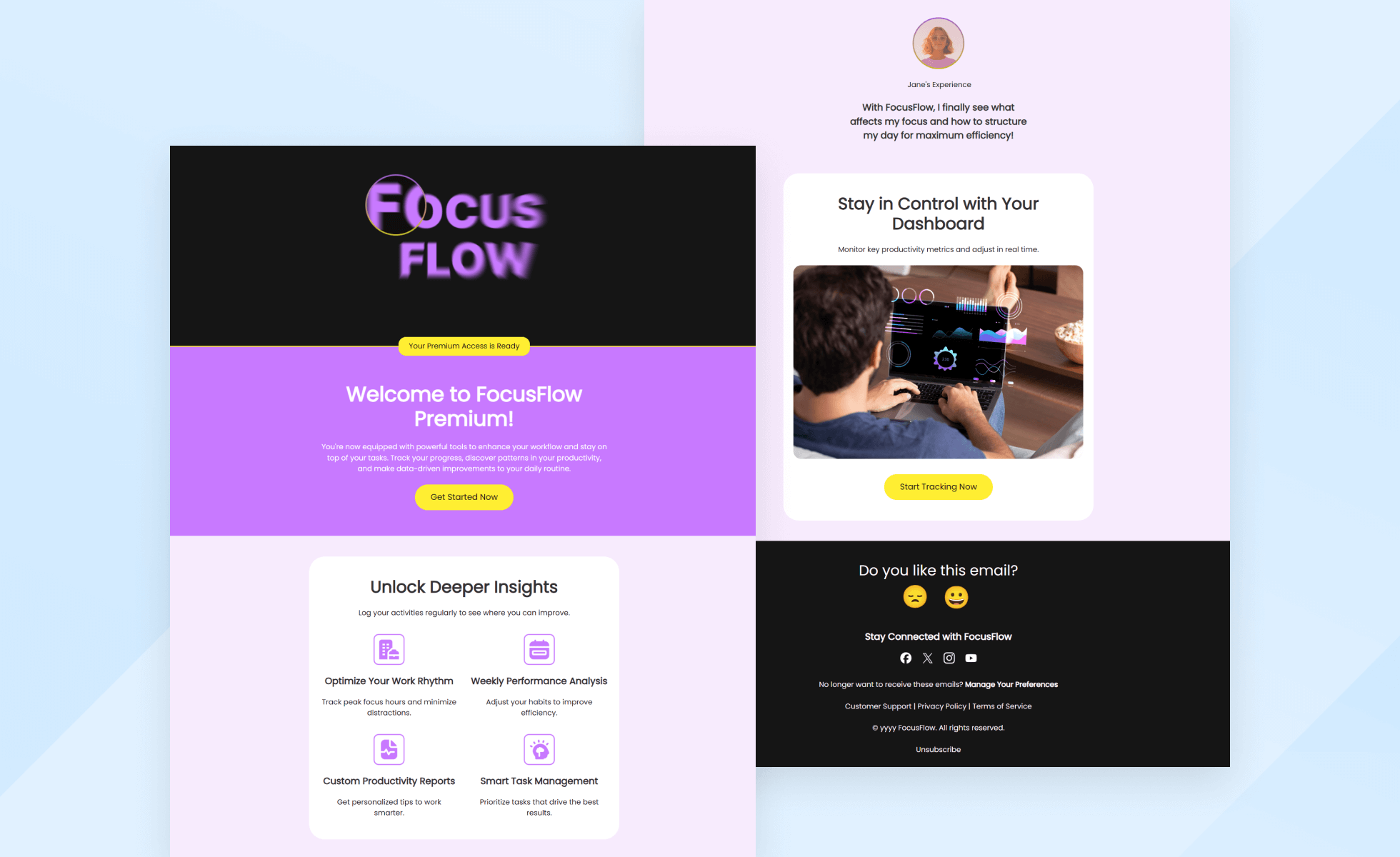
Promotional emails
Promotional emails are essential for driving sales and boosting customer engagement. They often motivate subscribers to make a purchase by highlighting attractive promotions, such as special offers, discounts, and exclusive deals.
Emails in this category create a sense of urgency with appealing promotions, increasing the likelihood of immediate action. By featuring new products or seasonal offers, promotional emails keep customers informed and excited.
3. Limited-time offer
A limited-time offer email promotes a special deal that’s available only for a short period. This creates scarcity and encourages customers to take advantage of the promotion on the spot, boosting short-term sales and engaging subscribers with exclusive opportunities.
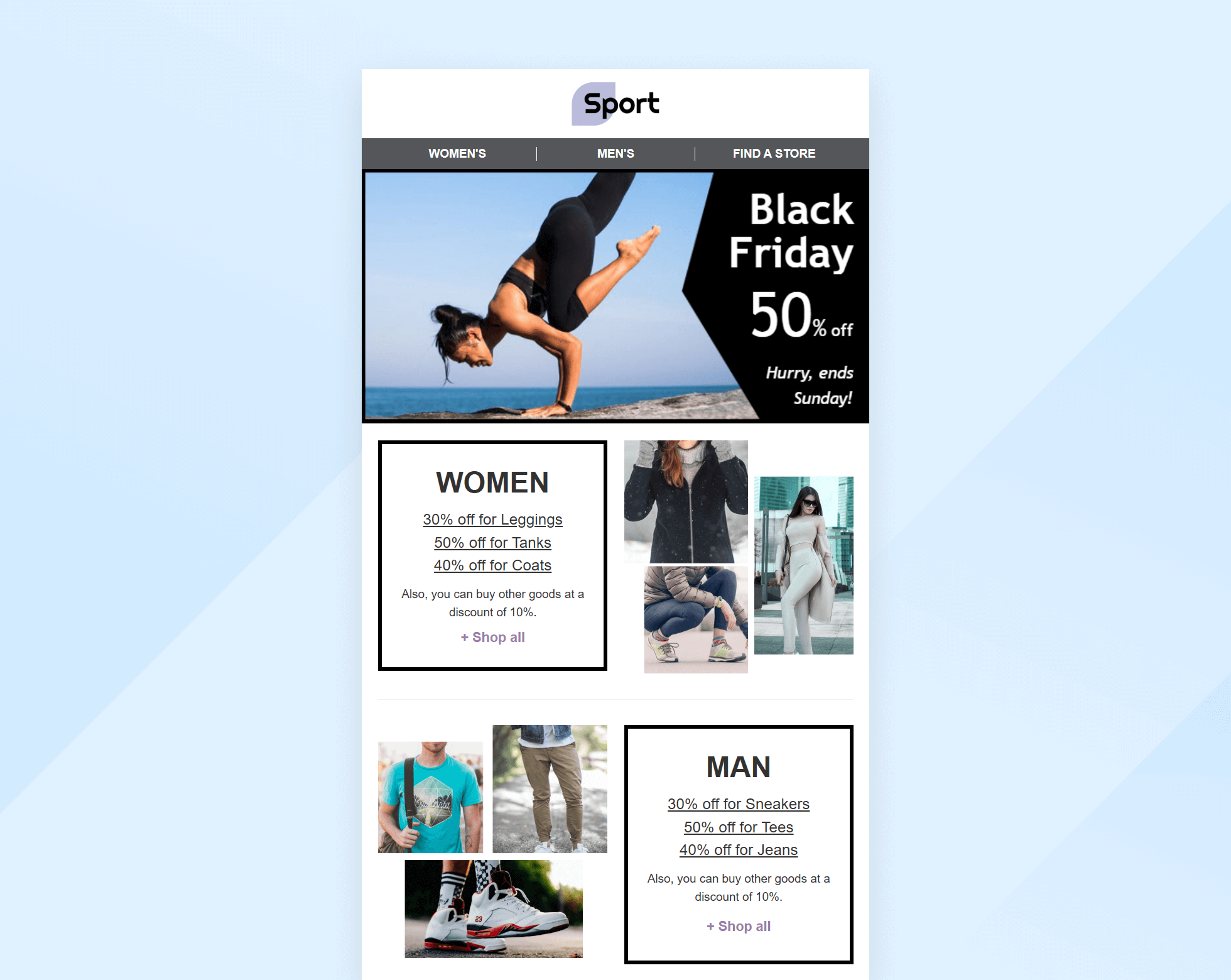
4. Seasonal promotion
A seasonal promotion email highlights special offers tied to holidays or seasons, leveraging the influence that festive mood has on buyer behaviors. By featuring season-specific products or discounts, this type of message can boost purchasing during peak shopping periods and enhance relevance and engagement.
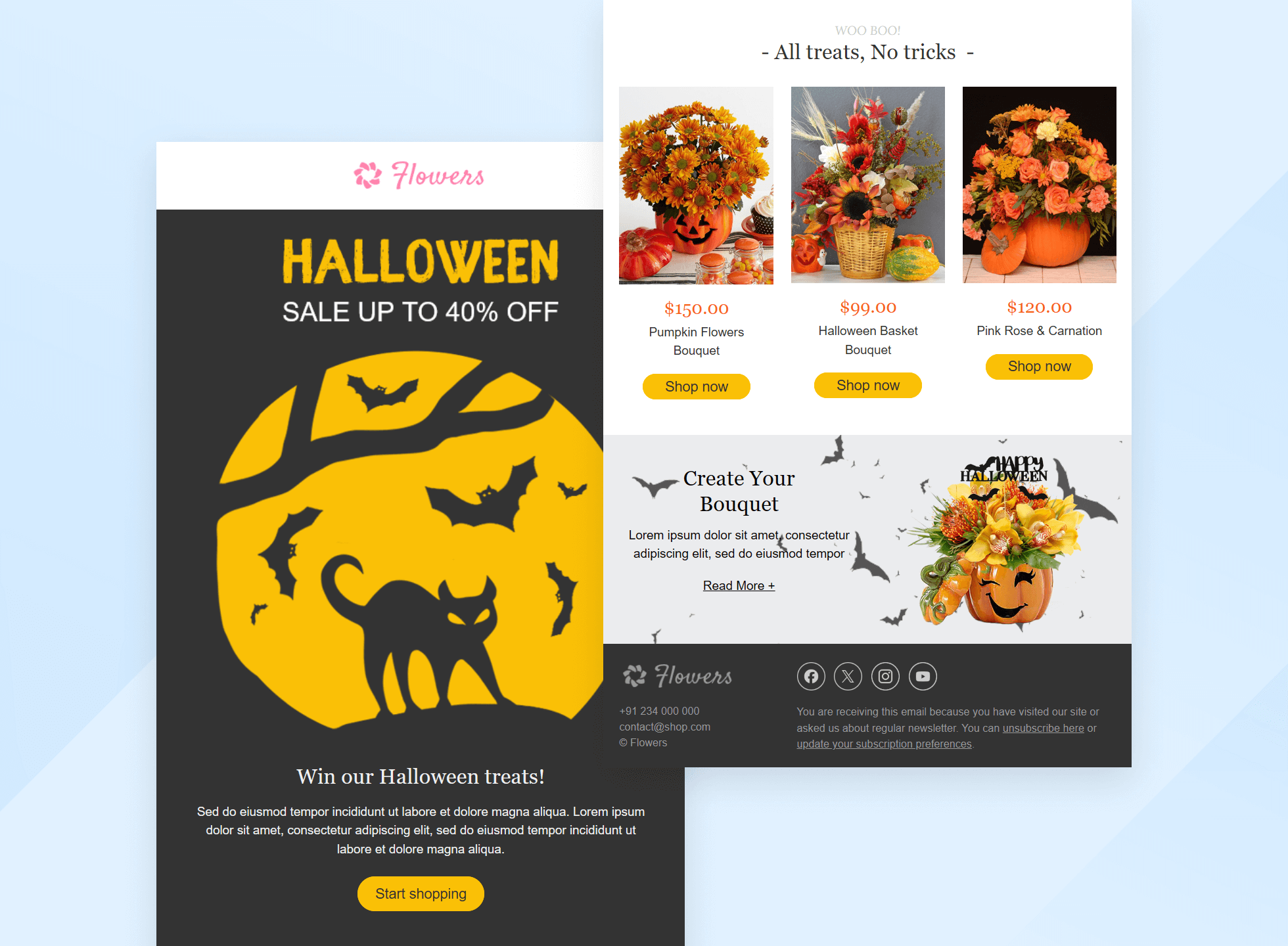
Newsletter emails
Newsletters are a convenient example of email marketing for keeping customers informed and engaged through regular updates generally sent on a weekly or monthly basis. There are various types of content you can include in yours:
- Company news
- Product launches
- Industry trends
- Blog articles
- Videos
Newsletters foster a sense of community and connection between the brand and its customers through transparency and timely information sharing. This encourages repeat visits and sustained interest.
5. Content-rich newsletter
A content-rich newsletter offers valuable and diverse content such as articles, tips, and industry insights. This leads to increased reader engagement, as it positions the brand as an authority in its sector and encourages regular interaction by consistently providing informative and interesting material.
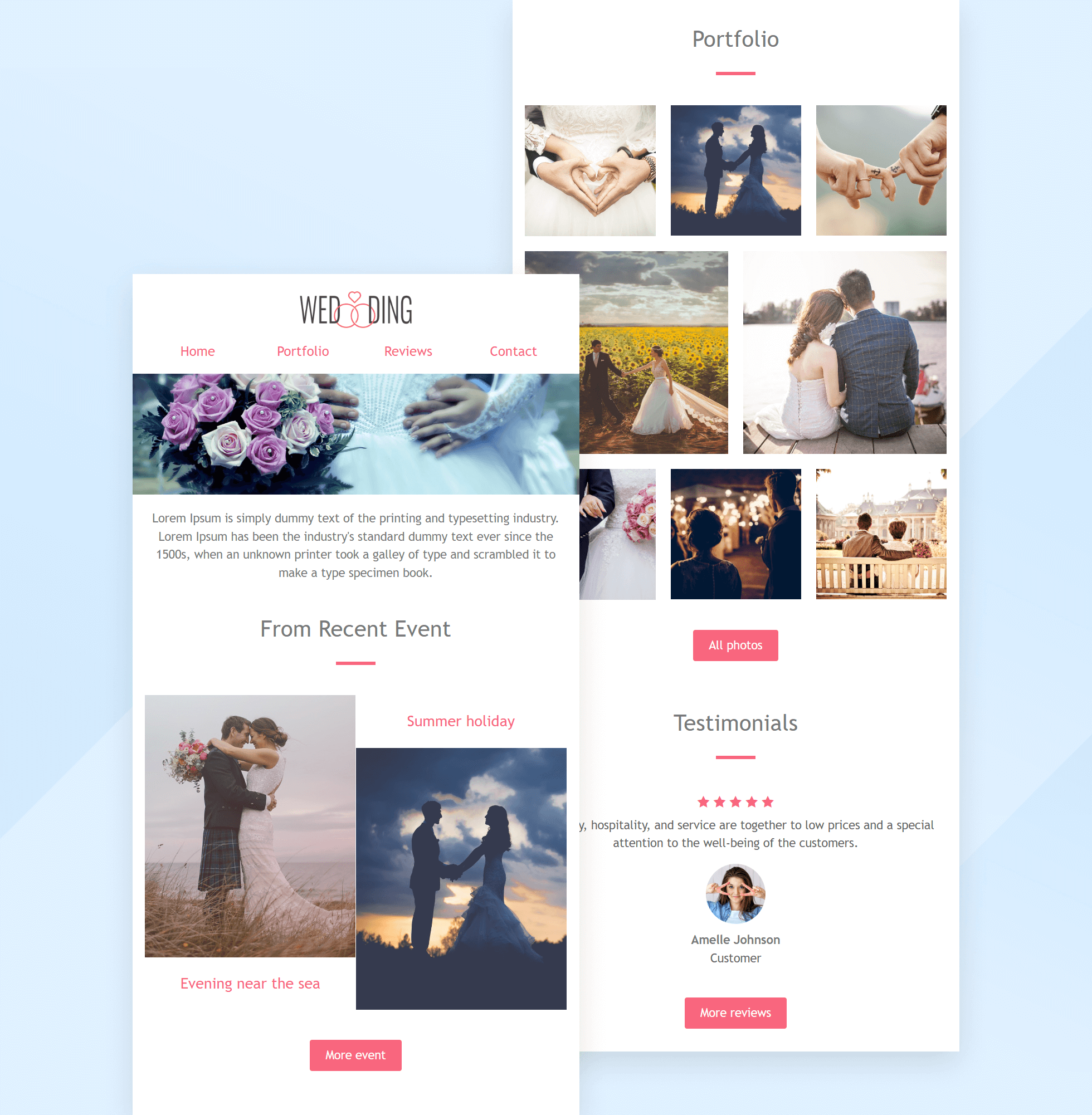
6. Minimalist design newsletter
A minimalist newsletter features clean and simple layouts with concise content formatted in a readable manner. This enhanced focus on key messages gives off a professional feel and makes it easier for subscribers to absorb and act on the information provided.
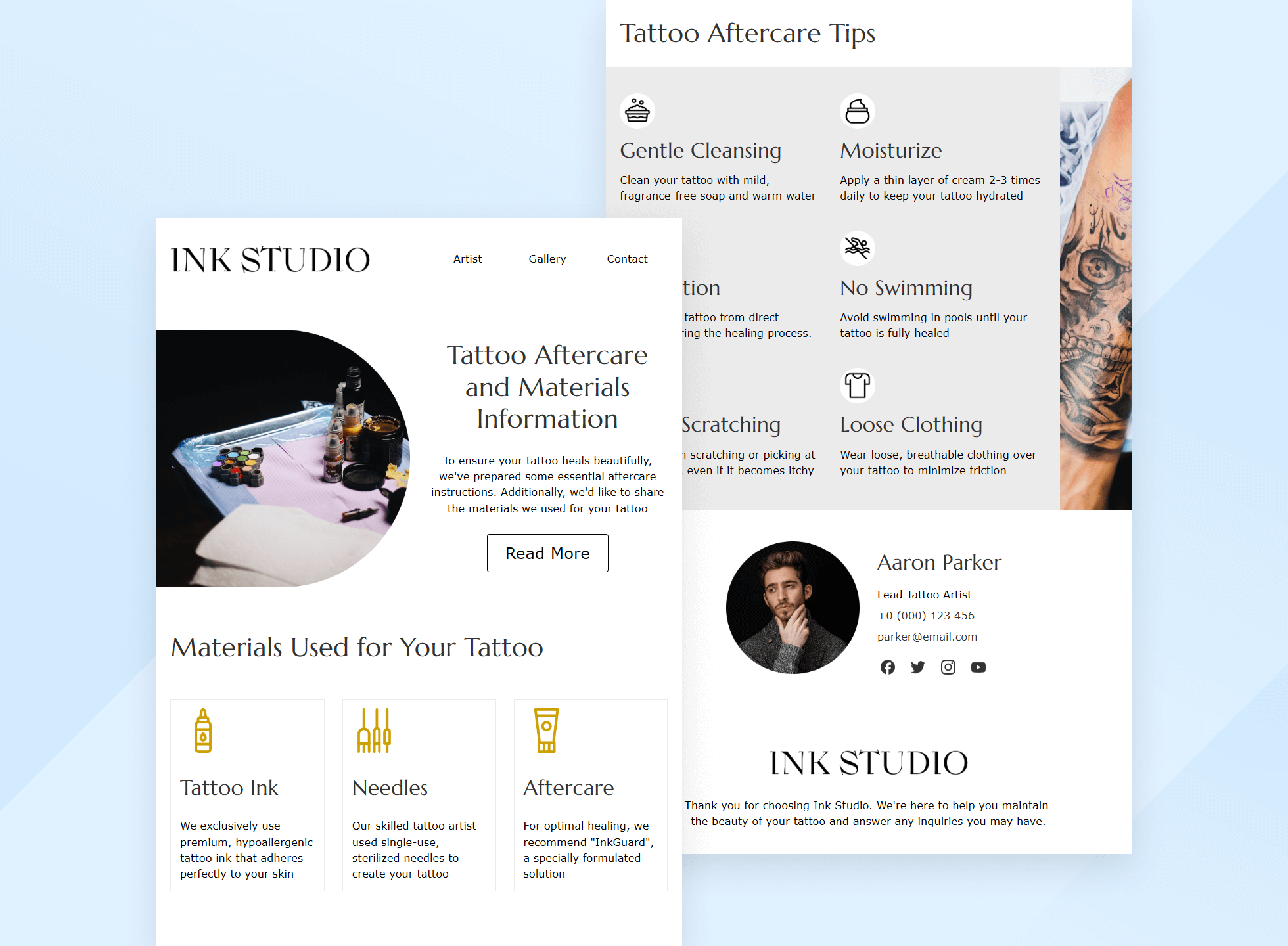
Abandoned cart emails
Abandoned cart emails are a great asset for recovering lost sales and reminding customers of items left in their online shopping carts. These messages nudge potential buyers to complete their purchase, often including incentives such as discounts or free shipping to encourage action.
By addressing common barriers to purchase and providing a convenient link back to the cart, abandoned cart emails reduce cart abandonment rates and increase conversion rates. They also enhance the overall shopping experience by demonstrating attentiveness on the part of the brand.
7. Reminder email
A reminder email notifies customers about items left in their shopping carts, prompting them to complete their purchase. This not only helps businesses recover potential lost sales but also increases conversion rates and demonstrates high-quality customer service.
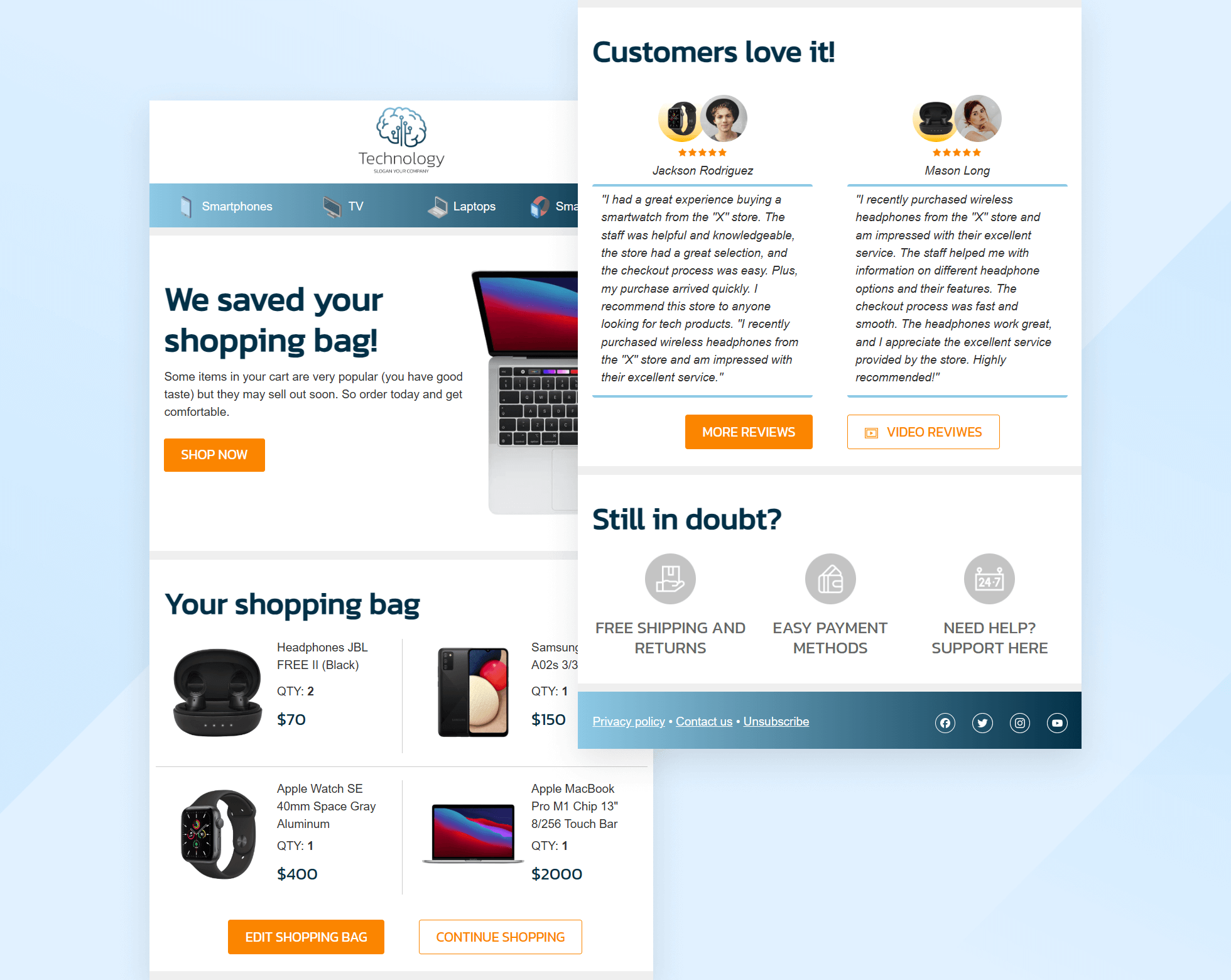
8. Discount offer email
A discount offer email for an abandoned cart provides customers with a special discount on items left in their cart. This incentive encourages immediate action and purchase completion, boosting overall revenue and customer loyalty.
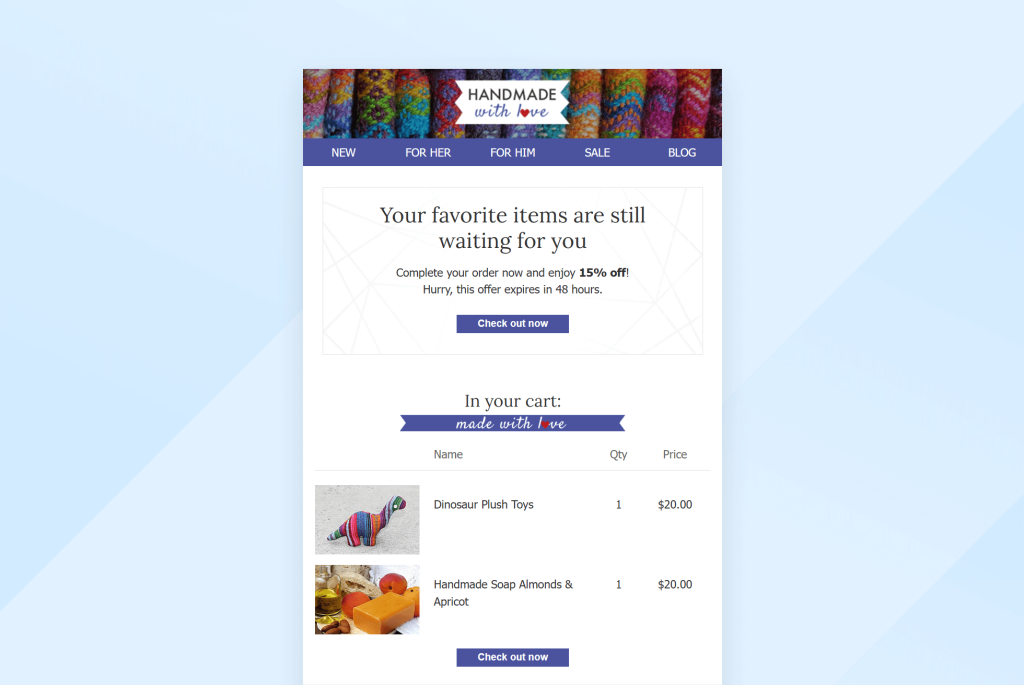
Re-engagement emails
Re-engagement emails can help you reconnect with inactive subscribers and revitalize their investment in your brand. You can include several elements in them to spark interest:
- Special incentives
- Personalized content
- Product updates
- Feedback requests
By addressing the reasons for inactivity and providing relevant solutions, re-engagement emails help reduce churn rates and improve overall email list health. They also demonstrate the brand’s commitment to maintaining a relationship with its audience, enhancing customer loyalty in the long run.
9. ‘We miss you’ email
Sending a ‘we miss you’ email is a friendly way to reach out to an inactive customer and potentially re-engage them. This simple personalized approach can encourage them to visit your website or even make a purchase.
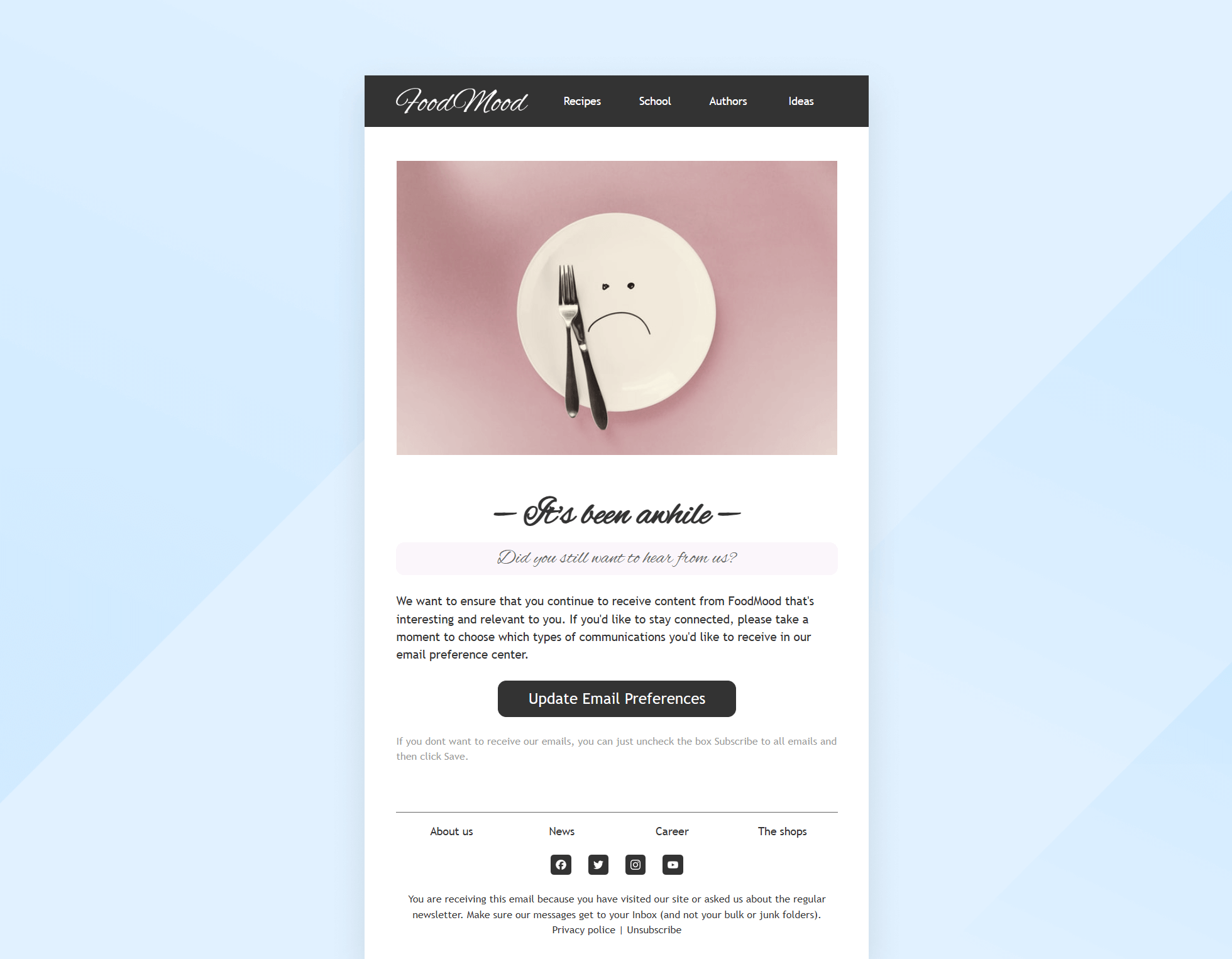
10. Feedback request email
Feedback requests are also valuable for re-engagement strategies. Asking inactive subscribers for their opinions on your company’s products or services is a great way to re-establish communication and show users that their opinions matter.
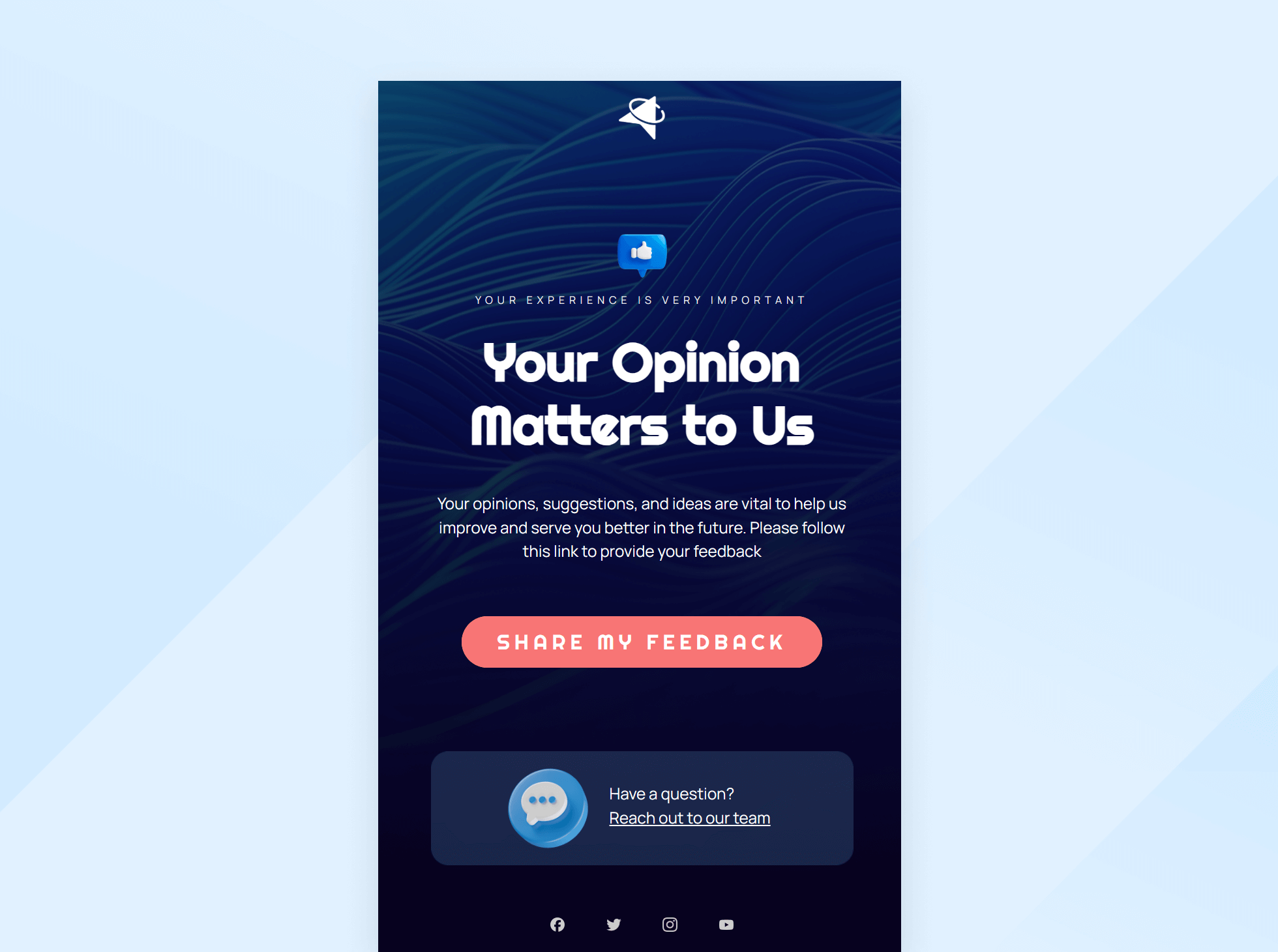
Transactional emails
Transactional emails provide timely updates on the status of a purchase, keeping customers informed about their orders at every step in the buying process. There are various types:
- Order confirmations
- Payment receipts
- Shipping notifications
- Delivery notifications
By delivering immediate and relevant details, transactional emails enhance the customer experience, build trust, and reduce anxiety related to online transactions. They also offer opportunities to reinforce brand messaging, encouraging customers to keep engaging with your business.
11. Order confirmation email
An order confirmation email provides customers with the details of their purchase, including an overview of the items ordered, their prices, and expected delivery dates. They provide reassurance that the order was successful, reducing post-purchase anxiety through a detailed record of the transaction.
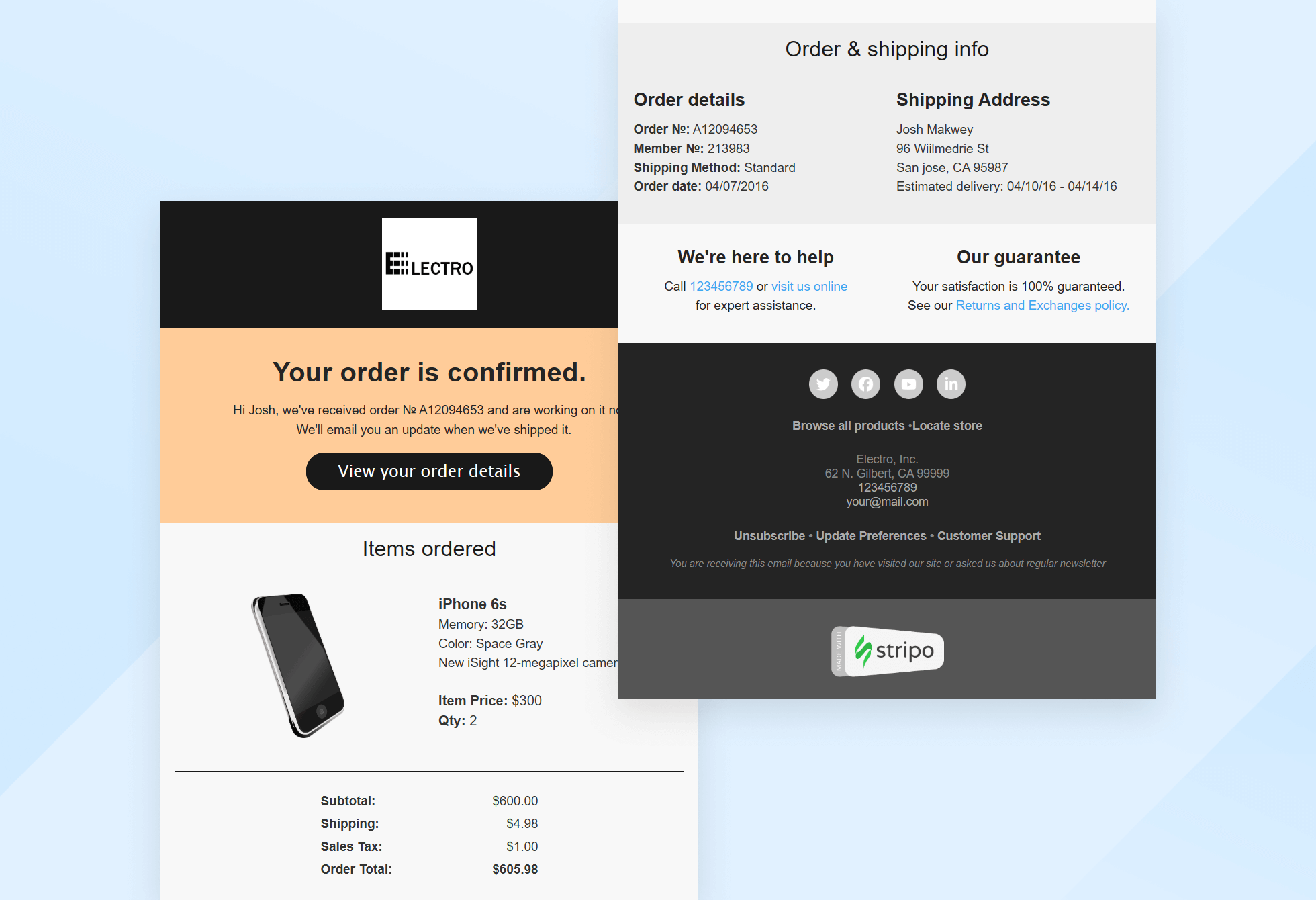
12. Shipping notification email
A shipping notification email informs customers that their order has been shipped, reducing inquiries about shipment progress and building trust through transparent communication. It often includes tracking information and expected delivery dates.
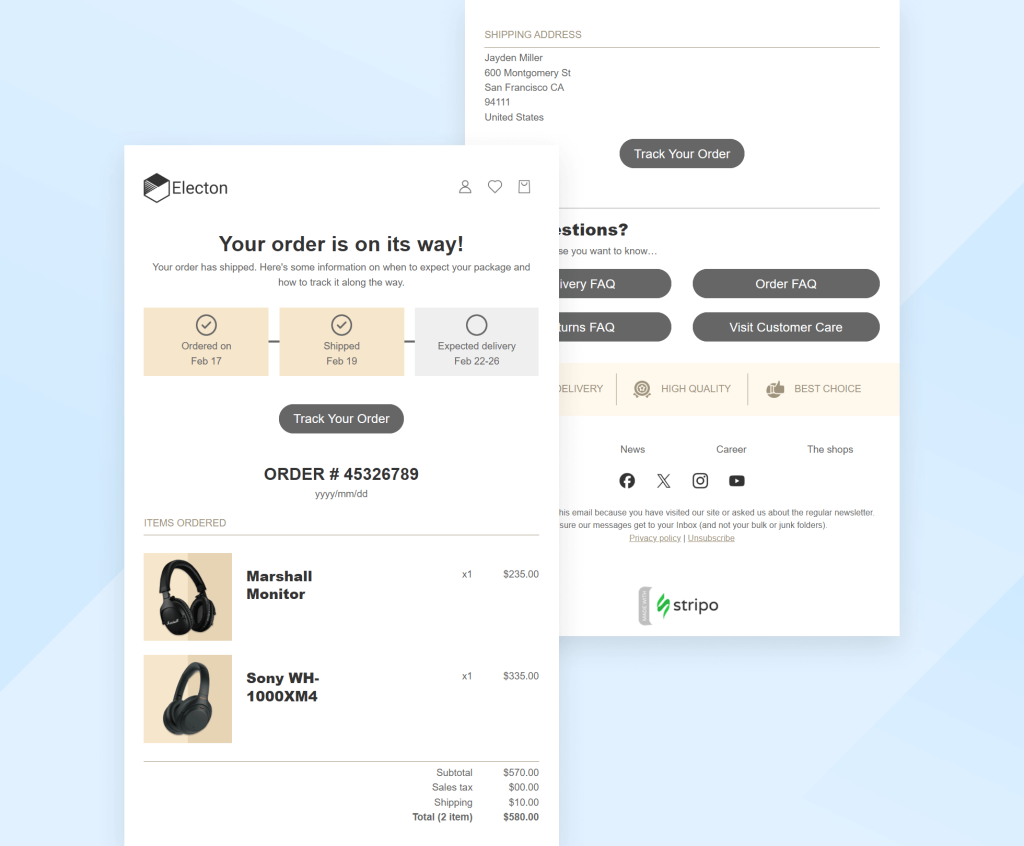
Event invitation emails
Event invitation email marketing examples are direct and personalized email marketing examples that inform and excite potential attendees about upcoming events. They provide key details about the occasion, such as the date, time, location, and agenda.
These messages create anticipation and urgency, often including compelling visuals and clear calls to action to encourage recipients to RSVP or register. By targeting the right audience and highlighting the benefits of attending, invite emails can significantly increase participation.
13. Webinar invitation
Webinar invitation emails are sent out for online events, such as seminars, debates, presentations, panels, and more. They are a great way to build a brand reputation and showcase expertise, generating leads by encouraging attendance and participation.
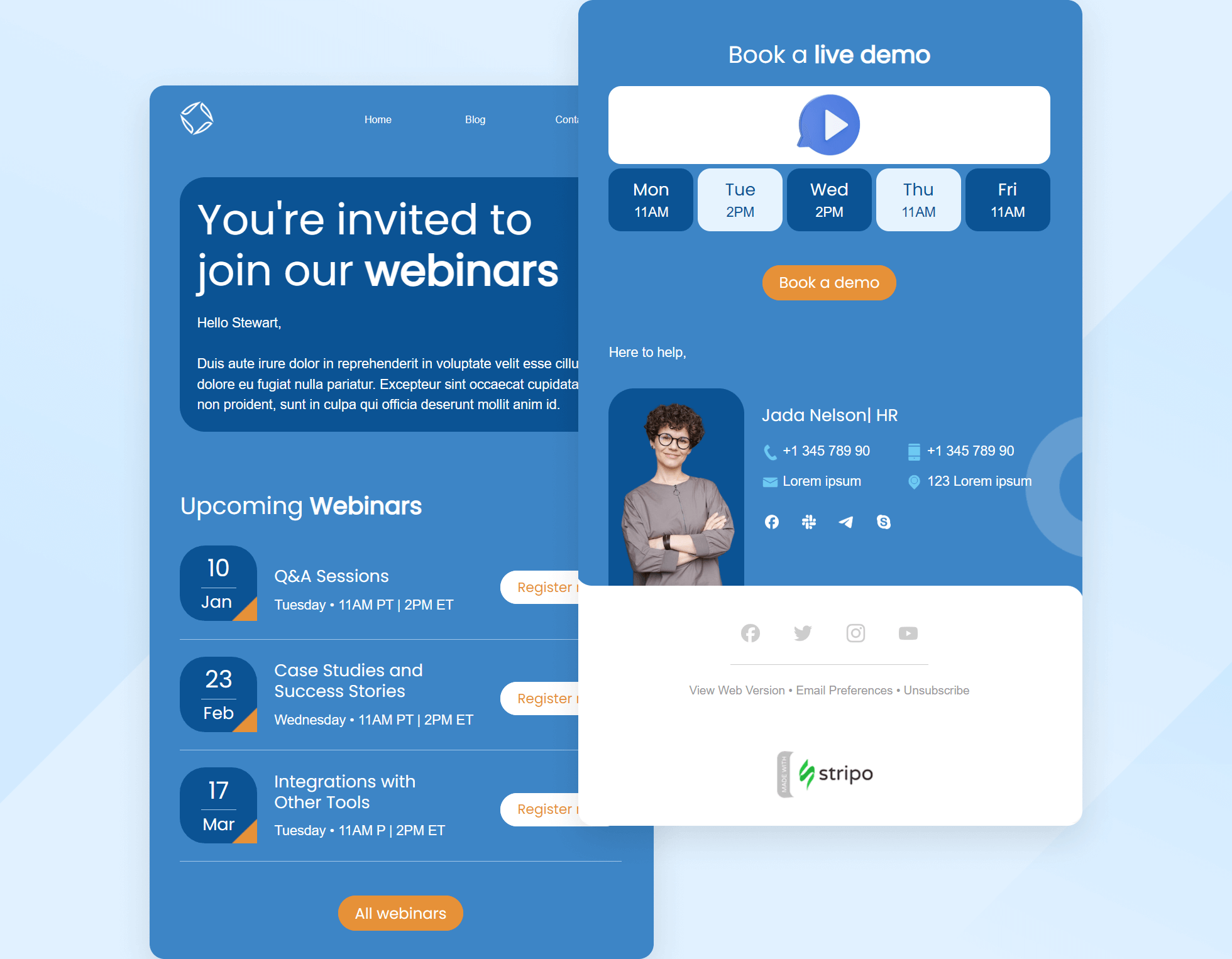
14. In-person event invitation
An in-person event invitation email invites recipients to attend a physical event, providing details like venue, date, time, and RSVP instructions. Physical events foster direct interactions with customers, building stronger personal connections and enhancing your brand presence.
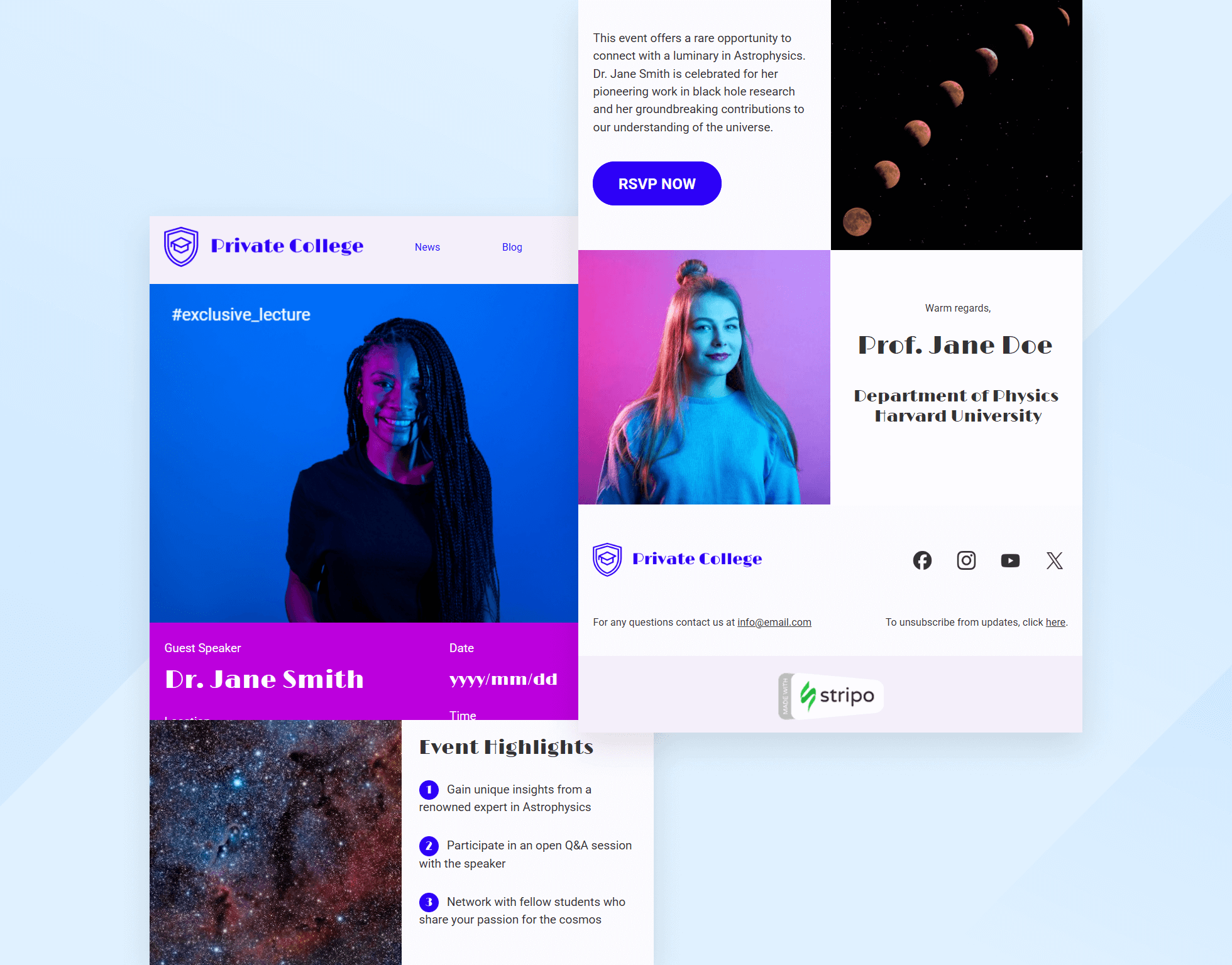
Survey and feedback emails
Survey and feedback emails provide a direct channel for customers to share their opinions, experiences, and suggestions. They can help businesses:
- Discover product & service strengths
- Identify areas that need improvement
- Understand customer preferences
By actively seeking customer input, companies can showcase how much they value their users’ opinions and foster a sense of brand loyalty. These insights enable data-driven decision-making, leading to improved products, services, and overall customer satisfaction.
15. Customer satisfaction survey
A customer satisfaction survey email requests feedback on a customer’s experience with a product or service. Sending one will demonstrate that your company is committed to continuous improvement.
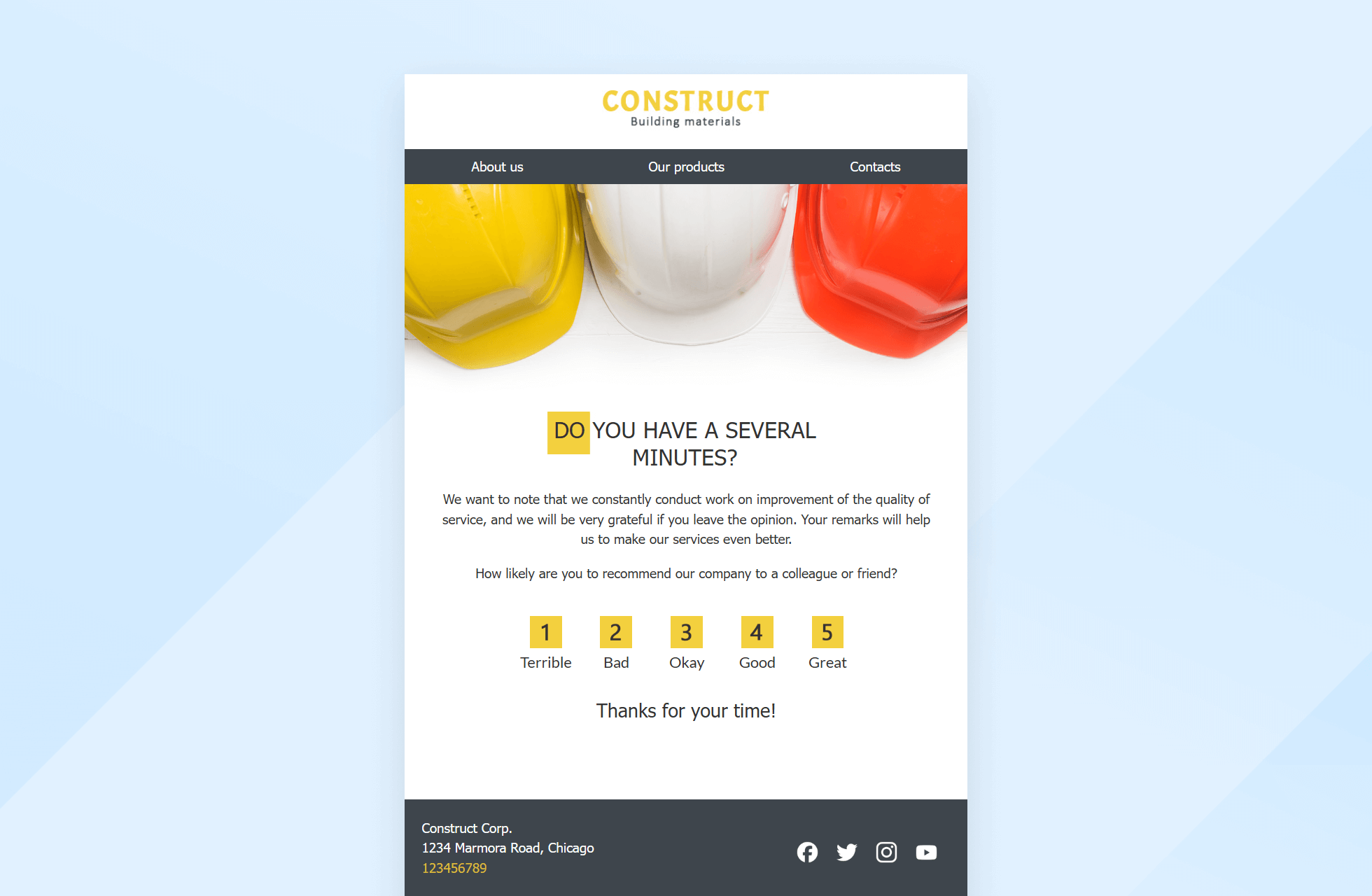
16. Product feedback request
The product feedback request is a specific email marketing example that asks customers about their experience with an individual product. It’s usually sent to identify areas for future improvement in a particular offering.
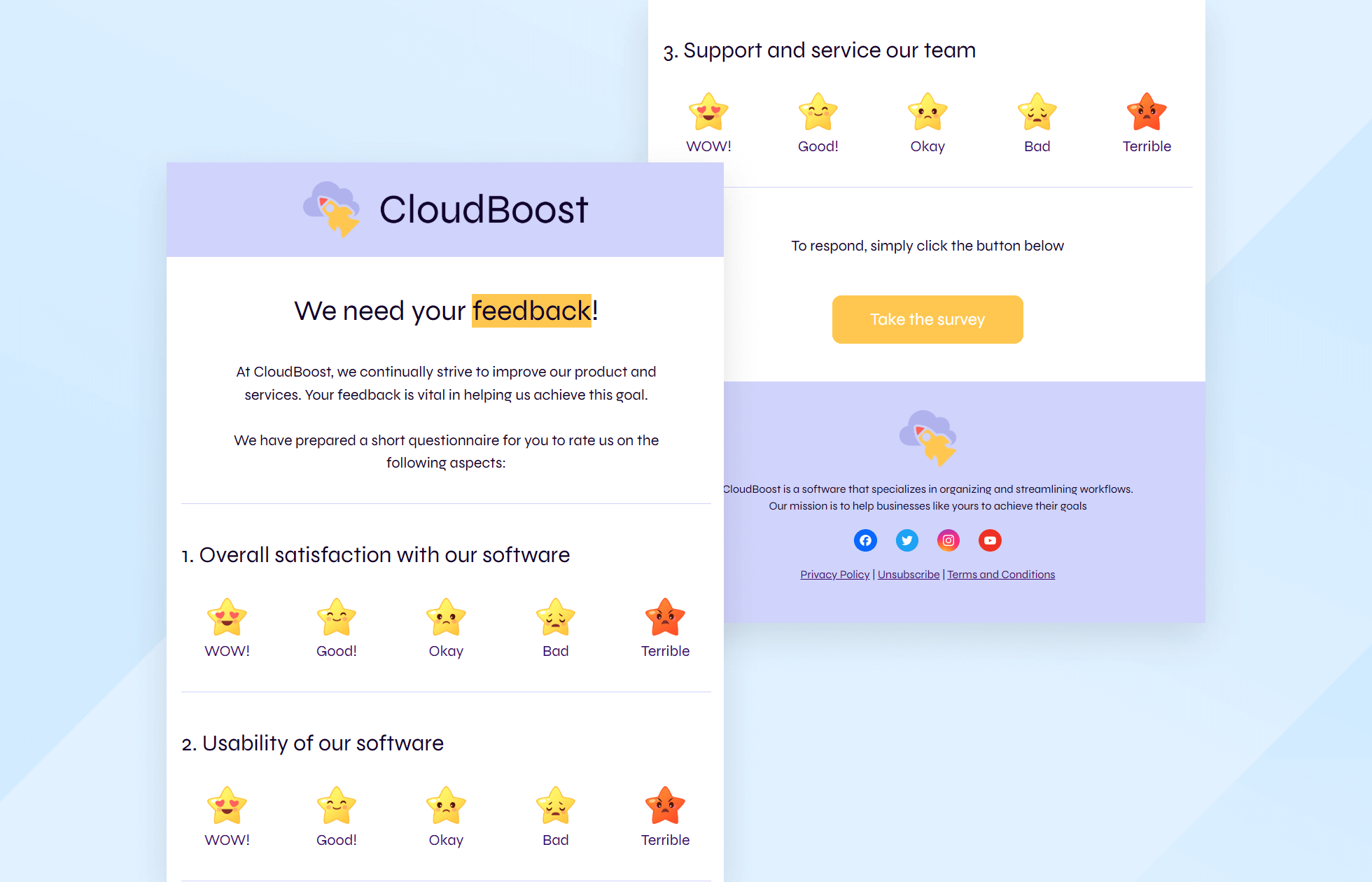
Milestone emails
Milestone email marketing examples are another entry in the list of examples of email marketing initiatives that make your customers feel valued and seen. You can send them out during special times such as birthdays, brand anniversaries, and other significant events.
These personalized messages show customers that the brand values and remembers their important moments, creating a deeper emotional connection.
17. Birthday celebration email
A birthday celebration email acknowledges a customer’s birthday with a personalized message and often includes special offers or discounts. This not only encourages loyalty but can also drive sales through these exclusive promotions.
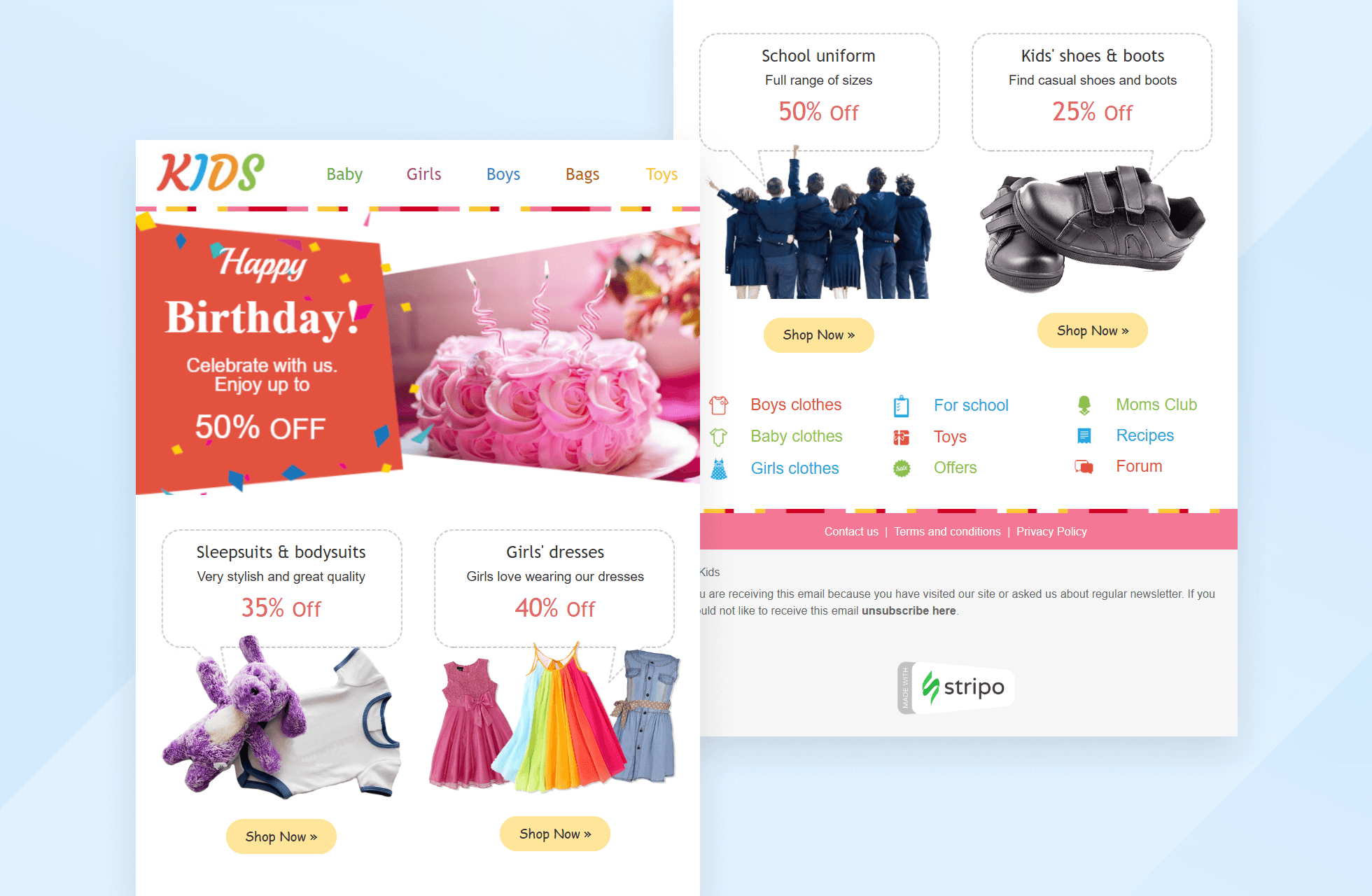
18. Anniversary email
The anniversary email celebrates a significant date related to a customer’s relationship with your brand, such as their sign-up or first purchase. Recognizing and appreciating how long they’ve been with you encourages repeat purchases and enhances retention rates.
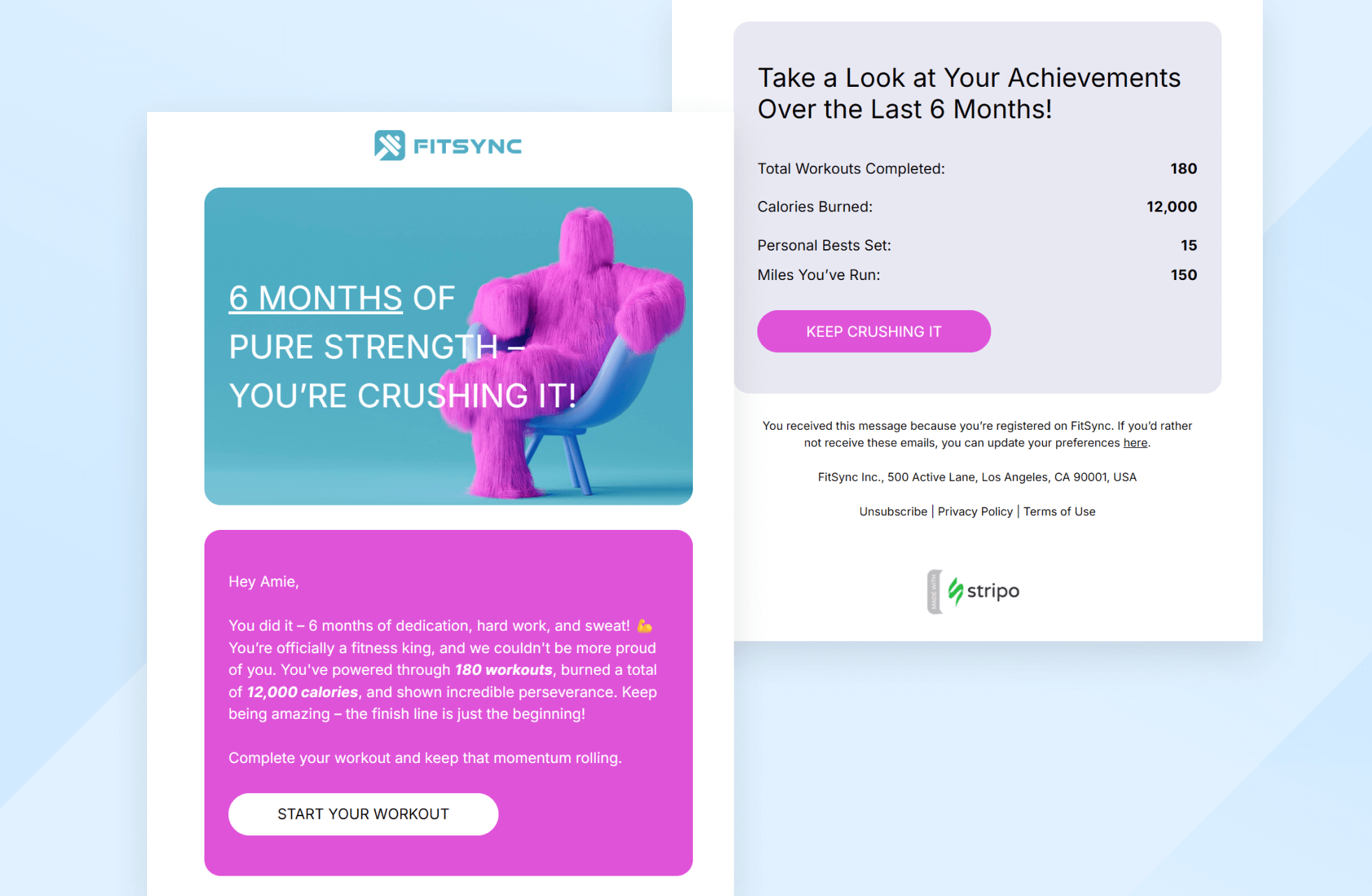
Holiday emails
Holiday email marketing examples leverage the festive spirit around seasonal events to bring special promotions, limited-time offers, and exclusive deals. This creates a sense of urgency and excitement, which drives customers to make purchases for themselves and their loved ones.
By aligning marketing efforts with holidays, brands can capture customers’ attention when they are most inclined to make purchases. Holiday emails also enhance customer engagement through festive greetings and personalized messages, fostering a stronger emotional connection.
19. Winter holiday promotion email
The winter holidays promotion email highlights special offers and discounts available during the winter holiday season, such as Christmas and New Year. During this time, companies can tap into seasonal trends and encourage customers to shop with them.
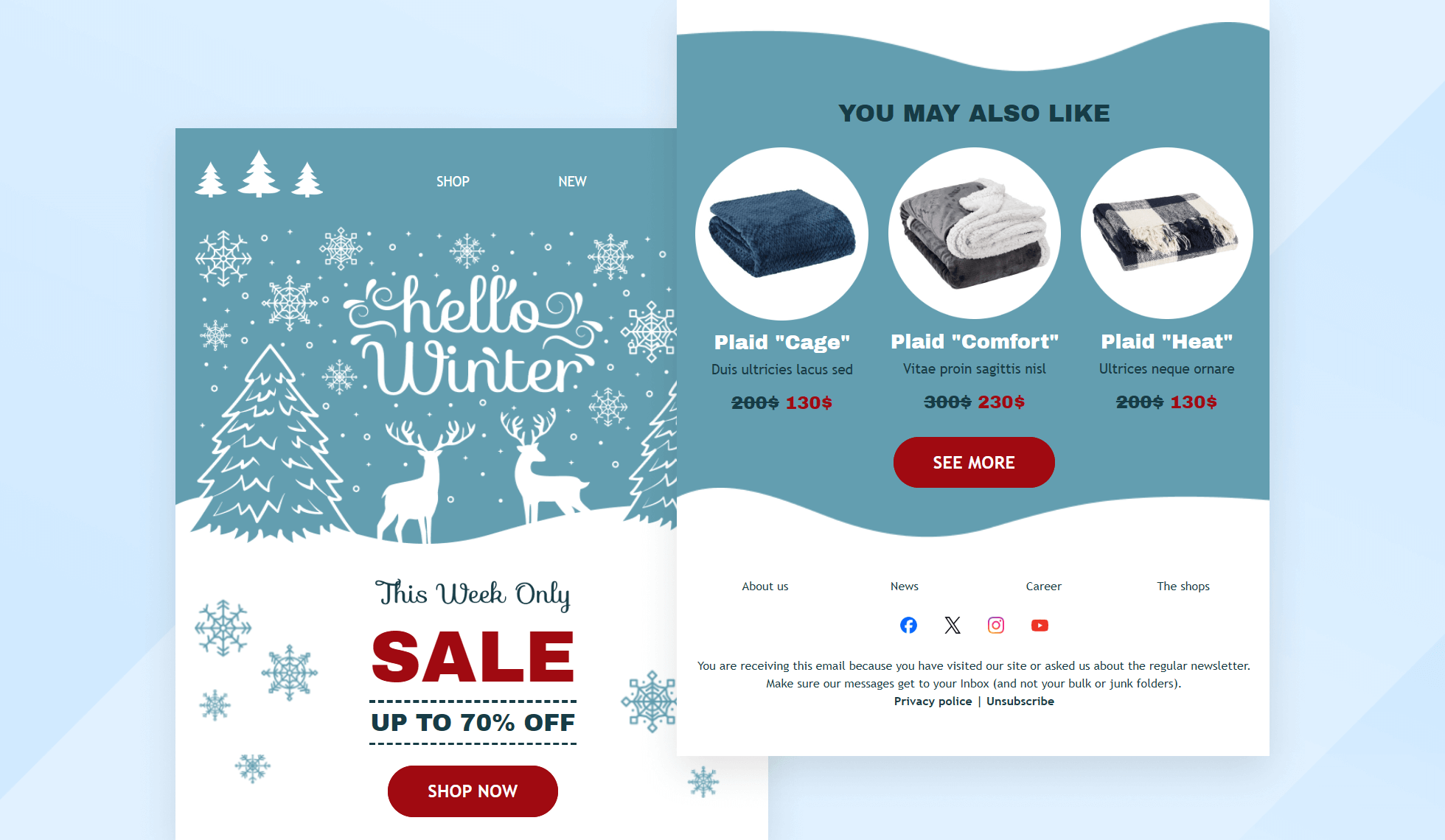
20. Black Friday & Cyber Monday email
Black Friday and Cyber Monday are two holidays dedicated exclusively to shopping. This is why most brands promote exclusive and time-sensitive deals that are available only during these major events.
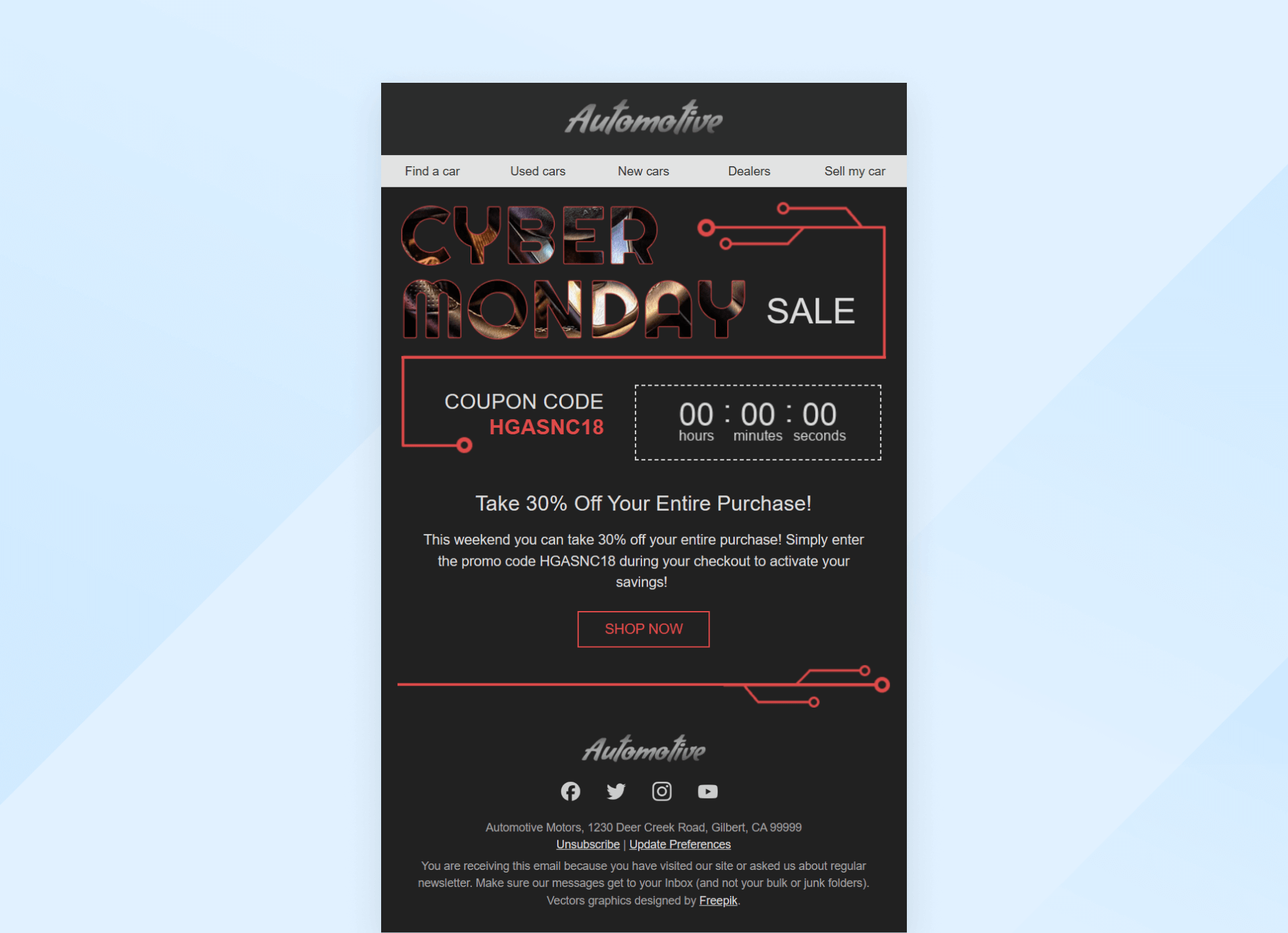
Get started with email marketing
Familiarizing yourself with the various types of emails you can send is the first step. The success of these email marketing campaign examples depends on a few key practices: personalize your content, use effective calls to action, and optimize your messages for mobile devices.
Explore 1,600+ email templates.
Create, send, and track business messages in one place with Textmagic.
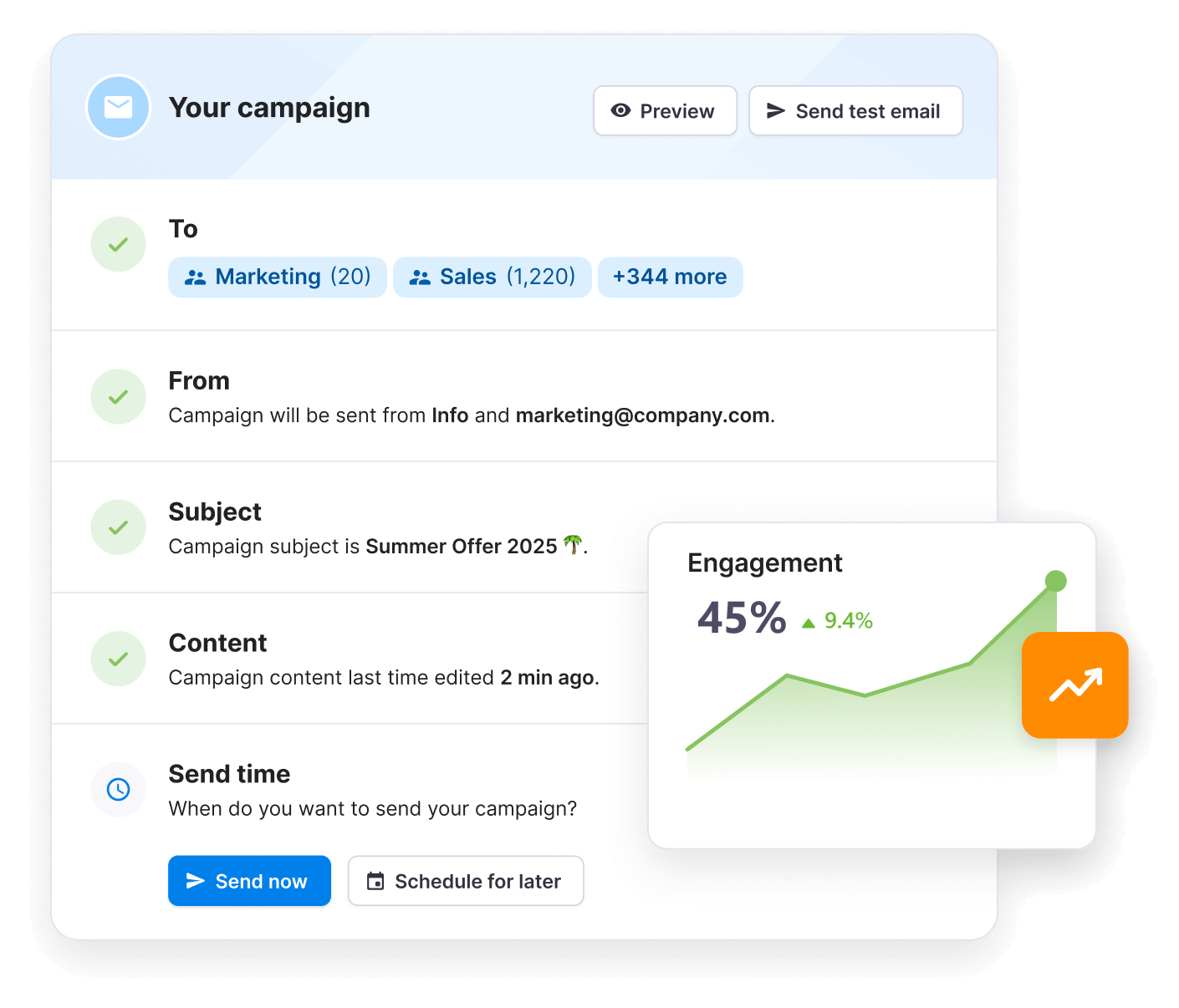
Experiment with different email categories and approaches to discover what resonates most with your audience.
Stay consistent, be creative, and always aim to provide value. This is how you’ll build strong relationships and achieve long-term growth.
Frequently Asked Questions (FAQs)
Welcome emails, product updates, and re-engagement campaigns tend to drive the most interaction. They offer value, reflect the subscriber’s needs, and arrive when they’re most impactful.
Be aware that timing and tone matter just as much as content.
There’s no one-size-fits-all rule, but consistency is key.
Most brands see results sending 1-4 emails per month, depending on audience and content quality. You want to stay on their radar, not in their way.
Use clear, permission-based sign-up forms and offer value in exchange, such as a discount, free resource, or insider access.
Avoid purchased lists; organic growth leads to better engagement and trust long-term.
You can use Textmagic to collect subscribers through compliant opt-in forms, manage consent, and launch targeted email campaigns, ensuring ethical growth from the first interaction.
A strong subject line, a recognizable sender name, and clear value up front.
Personalization and relevance boost open rates, but so does a sense of curiosity. If it feels like spam, it probably reads like spam too.
Related articles
10 Ways to improve your business text message writing
Crafting a strong message is a lot harder than it lo...
The 20 best sales enablement tools to empower your sales team
Discover the best sales enablement tools for B2B and...
Top 15 best customer service companies: Setting the gold standard
Companies face a $3.7 trillion annual risk due to ba...
How Do Scammers Get Your Cellphone Number and How to Protect Yourself
Scammers get your phone number and use highly sophis...
SMS for healthcare: How to improve patient care with text messaging
Text messaging’s main appeal lies in its acces...




